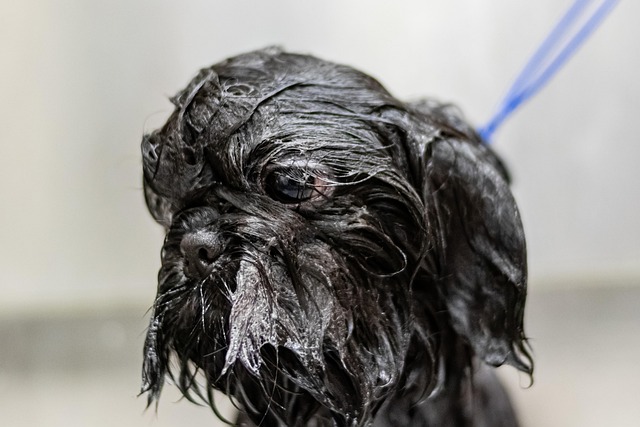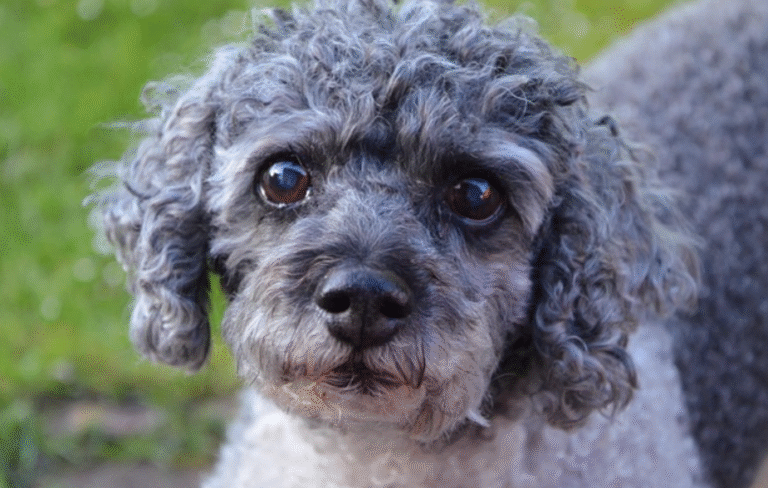Blue merle poodles are an extremely rare color variety of the poodle breed. They’re easily recognizable thanks to their striking coat pattern, which is a combination of bluish-gray patches swirled with black. Known for their affectionate, intelligent, and playful nature, these dogs share all the other wonderful qualities found throughout the entire poodle breed.
With these magnificent colors, they turn heads wherever they go, whether it’s in the local park or on crowded city sidewalks. In the United States, blue merle poodles are available in all sizes, from toy to standard. Most importantly, they pass the breed’s rigorous standards for health and temperament!
All over the country, families are adopting them both for their good looks and their intelligent, trainable disposition. Want to learn more about these unique blue merle poodles? After that, we’ll discuss their proper care and health, and what you can expect as an owner of these wonderful pets!
What Is A Blue Merle Poodle?

Among poodles, a blue merle poodle is unique due to its special coloring. This coat combines gray, black and occasionally white, with dashes and spots that appear nearly airbrushed.
Why the blue merle poodle color is so rare It’s easy to see why so many people are captivated by these dogs, from their beautiful looks to the unique personality that every single one of them has.
1. The Striking Merle Pattern
The blue merle coloring created the mottled appearance seen in poodles, with a mix of gray, black, and blue. These patches and streaks make them unique, different from the solid or standard parti poodles that boast bigger patches of color.
No blue merle poodle is alike. Some will be predominantly blue-gray with only a few black spots; others display a chaotic arrangement of colors. This unpredictability results in each blue merle poodle being unique.
2. Merle Genetics: A Quick Look
Semi-dominant, this merle gene carries its own dangers. It only takes one copy in the dog to express the pattern. When both parents have that gene, the puppy is at a much greater risk of serious health issues.
These double merles are frequently born with sight or hearing impairments. At times the gene masks itself behind others, making genetic testing a smart choice before breeding or purchasing.
While some think the merle gene originated through cross-breeding, others argue that it is a natural genetic mutation.
3. Beyond the Coat: Poodle Traits
Poodles are some of the smartest dogs out there and enjoy learning. Blue merle poodles are just as trainable as their counterparts.
They are better for people with allergies, as they shed less than other breeds. Whether as adorable companions, skilled service animals, or elegant show competitors, poodles find their place in human lives.
4. Temperament: Still a Poodle?
Blue merle poodles are just as energetic and fun-loving, and friendly as all other poodles. Properly socialized at an early age, they will develop into polite, well-adjusted members of society.
Regardless of color, they still require consistent training, and they maintain their cheerful disposition.
5. A Rare Poodle Color Story
That said, blue merle poodles are relatively rare. Their history is subject to conflicting opinions, and breeders need to be vigilant in preventing health issues.
The combination of the rare color and unique appearance causes increased prices and waiting lists.
Merle Gene: Beauty & Risks

Blue merle poodles are particularly striking, with their beautiful streaks of blue, gray and black. It’s this stunning appearance that is caused by the merle gene. It changes how pigment is expressed in the coat, eyes and even skin.
Although the beauty of this color is striking, this gene adds some risk factors that all prospective owners and enthusiasts of these dogs should be aware of. With responsible breeding practices and well-informed owners, merle poodles can be vibrant and beautiful companions.
Understanding Merle Genetics Clearly
The merle gene is polygenic, meaning that it has multiple variants or alleles. For example, it will dilute a solid black poodle coat to a mottled blue-gray appearance.
A poodle with one merle gene (heterozygous) receives the color without taking on as high of a risk. Two merle genes (homozygous), however, can lead to severe health issues.
Genetic testing helps breeders know a dog’s merle status and plan litters. Since the merle gene is inherited from parent to pup, understanding the genetic inheritance of the parents is important.
Key Health Concerns to Know
Merle poodles suffer from hearing or vision loss, particularly if they receive two copies of the merle gene. Few are fully deaf or blind, and most have eye deformities.
Routine examinations help identify issues before symptoms develop. Responsible breeders rely on extensive health testing and careful pairings to reduce these risks.
The “Double Merle” Danger Zone
A dog that is a double merle, on the other hand, has two copies of the merle gene. Because of the fact that they are double merles, these dogs are at greater risks for deafness, blindness, and additional health complications.
Cocoa and Pepper’s ethical breeder would have never paired them—two merles—to avoid this.
Breeding Merles Responsibly Now
What responsible breeding looks like now Responsible breeding involves genetic testing and breeding merle only to non-merle. Good breeders provide health clearances, and they are concerned about the quality of life for their puppies.
Open and transparent breeding practices ensure that your family can adopt a healthy, happy blue merle poodle.
Blue Merle Poodle Care Guide

Caring for a Blue Merle Poodle just takes some understanding. Every dog is an individual with varying needs, but some things stay the same. In return, these poodles require routine grooming, ample exercise every day, quality nutrition, and regular veterinary care to keep them happy and healthy.
Famed for their flashy coats, Blue Merle Poodles’ beautiful blend of blue, gray, and black are eye-catching. It needs more attention than a solid coat would. Owners in the U.S. Often see Blue Merle Poodles in three sizes: Toy, Miniature, and Standard, each with its own energy level and health needs.
Grooming That Unique Coat
Blue Merle Poodles require brushing at least three to four times a week to prevent their curls from matting. Use a slicker brush for the top coat and a metal comb for tangles deeper in the coat. Give them a bath once a month, or more if they’re outside a lot.
Here’s a simple tool list:
- Slicker brush
- Steel comb
- Dog-safe shampoo and conditioner
- Blunt-tipped scissors
- Nail clippers
The average owner visits a pro groomer every three to four weeks. Only grooming professionals can trim, bathe, and spot potential skin issues early. This not only helps your Poodle’s coat stay healthy, but it helps maintain the coat’s unique and unusual pattern.
Poodle Exercise Essentials
Blue Merle Poodles require a minimum of 30 to 60 minutes of exercise daily. Regular walks through the park, a game of fetch, or a swim at the beach all contribute. Puzzle toys and obedience games make sure their sharp minds stay equally occupied.
Regular trips to the dog park teach valuable social skills and allow your poodle to meet other dogs in a controlled environment. A predictable schedule that includes a variety of activities and play styles is most effective.
Best Diet for Your Merle
A nutritious diet rich in protein, healthy fats, and essential vitamins helps maintain their coat’s luster and body condition. Poodles do best with:
- Lean meats (chicken, beef)
- Fish oil for coat health
- Whole grains, like brown rice
- Veggies, such as carrots
- Fresh water always
Portion size will vary based on size—Toy, Mini or Standard.
Vital Vet Visits Always
As dogs age, they become more susceptible to various health issues. Vets look for vision and hearing issues associated with the merle gene. Core shots, flea & tick meds, and regular dental cleanings are essential.
Routine visits can catch conditions such as dermatological conditions or early stages of ophthalmologic diseases.
Popular Blue Merle Poodle Mixes

Blue merle poodle mixes turn heads with their unique and beautiful coats, and they often give you the best of both parent breeds. These mixes take the poodle’s brains and their hypoallergenic, low-shedding coat. They bring in interesting traits from the other breed, usually creating a sociable, intelligent, energetic friend that does well in diverse environments found all over the U.S.
The blue merle mutation produces mottled grey, black, and occasionally white patches. This beautiful mix of coat types and colors makes every dog look truly unique.
The Appeal of Merle Mixes
Unfortunately, merle mixes have become increasingly popular in American cities and suburbs. It’s easy to see why so many owners are drawn to the unique coat patterns that appear in every litter. Hybrid vigor is the health perk mixed breeds get to enjoy. It results in fewer inherited issues and a longer life expectancy.
Since they come in such a wide variety of breeds, merle poodle mixes can have very different temperaments. Whether they’re calm and loyal or playful and outgoing, they’re the ideal companion for any lifestyle.
Common Merle Poodle Crosses
| Mix Name | Size Range | Coat Type | Typical Traits |
|---|---|---|---|
| Aussiedoodle | 30–70 lbs | Wavy/Curly | Energetic, intelligent |
| Bordoodle | 30–60 lbs | Soft, curly | Trainable, loyal |
| Shepadoodle | 50–90 lbs | Dense, curly | Alert, protective |
| Cockapoo | 12–24 lbs | Soft, wavy | Affectionate, social |
Each crossbreed inherits a unique combination of appearance and temperament, influenced by the lineage of both parental breeds. Understanding the breed standards and histories of each breed can really help identify what to look out for in terms of energy level, size, and coat care requirements.
What to Expect from Mixes
As you can see, these merle poodle mixes can vary widely in appearance—even among the same litter. Their temperaments can change, which is why starting their training and socialization early is important.
Health & Lifespan Owners should inquire about genetic testing with breeders, as merle genes can pose serious risks such as hearing or vision impairments. These mixes do best with regular grooming, lots of exercise, and regular checkups at the vet.
Finding Your Merle Poodle Pup

Finding your perfect blue merle poodle requires patience and diligence. Determine whether you would like to purchase from a quality breeder or adopt. Being informed about the merle coat color and poodle breed standards will ensure you find a healthy, happy merle poodle pup! The journey begins with a little research and a lot of patience.
Spotting Good, Ethical Breeders
When searching for a breeder, look for puppies raised at home, not in large kennels. Responsible breeders will provide full health records and genetic testing for parents. They should also be willing to answer all your questions and be involved with breed clubs and poodle groups.
Ethical breeders will be transparent with health information and will have tested their dogs for genetic disorders such as hip dysplasia and eye diseases. Breed clubs, including the Poodle Club of America, frequently have breeder referrals where they list breeders they have vetted. Meeting the breeder in person will give you the opportunity to see where the pups are being raised and to meet the parents.
Considering Merle Adoption Options
If you adopt a blue merle poodle puppy from a rescue or shelter, you’ll help him get a new lease on life. These communities exchange cultural and health information when they have knowledge of it. Inquire about health screenings, temperament, and any other established behavioral patterns.
Before bringing your new child home, prepare a small area with food, water bowls, crate, and toys. Providing an adopted dog a loving home may prove to be one of the most fulfilling experiences of your life.
Healthy Puppy Checklist
Check for clear eyes, clean ears, soft fur, and a happy, playful mood. Your new puppy should be happy, healthy, active, and curious. Dogs that received early socialization tend to be friendlier, more tolerant, and easier to train.
Request a written health guarantee against genetic anomalies. Even better, schedule a vet visit before you bring that puppy home.
Key Questions for Breeders
When speaking with breeders, consider asking the following questions:
- How do you raise your puppies?
- What health checks do you do?
- Can I meet the parents?
- What is your return policy?
- Will you provide references?
Understanding your puppy’s parents and health history will help you steer clear of any future surprises. An ethical breeder will maintain contact and encourage you to provide updates.
My View: Merle Poodle Magic

Blue merle poodles have an otherworldly charm that wins every heart. It is hard to believe their coats, stamped with dashes and speckles, are not air brushed. These remarkable dogs always turn heads, but not only with their stunning good looks; it’s with how they inspire all the feels in the people they meet.
The connection with a blue merle poodle is more than just owning a dog. It’s about life with a dog that keeps you guessing and laughing every day. Owning a breed that is this unique comes with unique responsibilities.
Why We Love Unique Coats
The appearance of a blue merle poodle is enough to turn heads and spark conversation. When neighbors spot the striking patches of blue, gray, and white from a distance, they usually stop to ask us what’s going on. Since these patterns seem uncommon in the poodle universe, owners usually experience a strong sense of pride.
Our local dog park becomes a gathering spot for conversations and stories about genetics, color, the breed, and our unique merled poodle. Many others tell stories of people stopping to take pictures or other dog owners inquiring about the merle gene. It’s participatory moments like these that foster a deeper sense of community and pride.
The Poodle Soul Shines Through
Even with their special coats, blue merle poodles are just as outrageous as any other true poodle. They are smart, eager to learn new tricks, and certainly love the attention. Thousands more participate in dog sports, where they display their intelligence and exuberance.
Keep reading to find out how their owners’ stories describe them as helpers, companions, and comedians in poodle form.
Owning Merles Thoughtfully Matters
Owning merles responsibly is important. Having a blue merle poodle is a wonderful thing. Some dogs are born blind or deaf due to the presence of the merle gene.
Responsible owners educate themselves on the health risks and care for their dogs with regular veterinary care, training, and plenty of love. They’re willing to tackle the unique challenges and delights of owning a rare dog.
The Real Cost of Rarity
Blue merle poodles require love and understanding beyond what most people can offer. Those good breeders, who screen for health issues, are more expensive.
For those of us with rare breeds, grooming and vet bills can add up quickly. Yet, most agree that the bond and joy they receive in return makes it all worthwhile.
Conclusion
With their stunning good looks and spunky personality, blue merle poodles will liven up any household. Their bold coats turn heads at the park, and their upbeat ways keep days busy and fun. As with any poodle, they require proper supervision, consistent training, and plenty of exercise. The merle gene can carry serious health risks, so responsible breeders will test pups and provide health information up front.
On the ground in Los Angeles, people go gaga for these dogs’ huge brains and even bigger hearts. If you’re looking for an eye-catching poodle, you may discover that the blue merle is exactly what you need. Visit your local animal shelter or reputable breeder to begin your search for your new canine companion. Want to learn more about blue merle poodles? Go in person, start local, and let your heart lead.
Frequently Asked Questions
What is a blue merle poodle?
A blue merle poodle is a poodle that features a striking blue, gray, and black marbled coat pattern, resulting from the merle allele, which plays a crucial role in coat color genetics within this dog breed.
Are blue merle poodles rare?
The rare and beautiful coat color of blue merle poodles results from a unique genetic combination, making these merle dogs rarer than regular solid-colored poodles and highlighting their distinct lineage.
Do blue merle poodles have health risks?
Blue merle poodles may be at increased risk for hearing or vision deficits due to the merle trait associated with the merle gene itself. Responsible breeding practices can significantly contribute to reducing these risks.
How do I care for a blue merle poodle’s coat?
Brush your blue merle poodle 3-5 times a week to avoid matting and promote a healthy coat. This is why routine grooming is key since their thick, curly coat may mat easily.
Are blue merle poodles recognized by the AKC?
While blue merle poodles can be registered, they may not meet the poodle breed standards.
Can blue merle poodles live in Los Angeles?
Most definitely, YES! Can blue merle poodles thrive in Los Angeles. They love walking, going to the dog park, and urban living, as long as there given their daily exercise needs and kept out of direct sunlight.
Where can I find a blue merle poodle puppy in the U.S.?
Research breeders—ensure you only consider those who conduct appropriate and extensive health tests on their dogs. Look with national poodle clubs or rescue organizations, as they may have merle puppies looking for homes.






